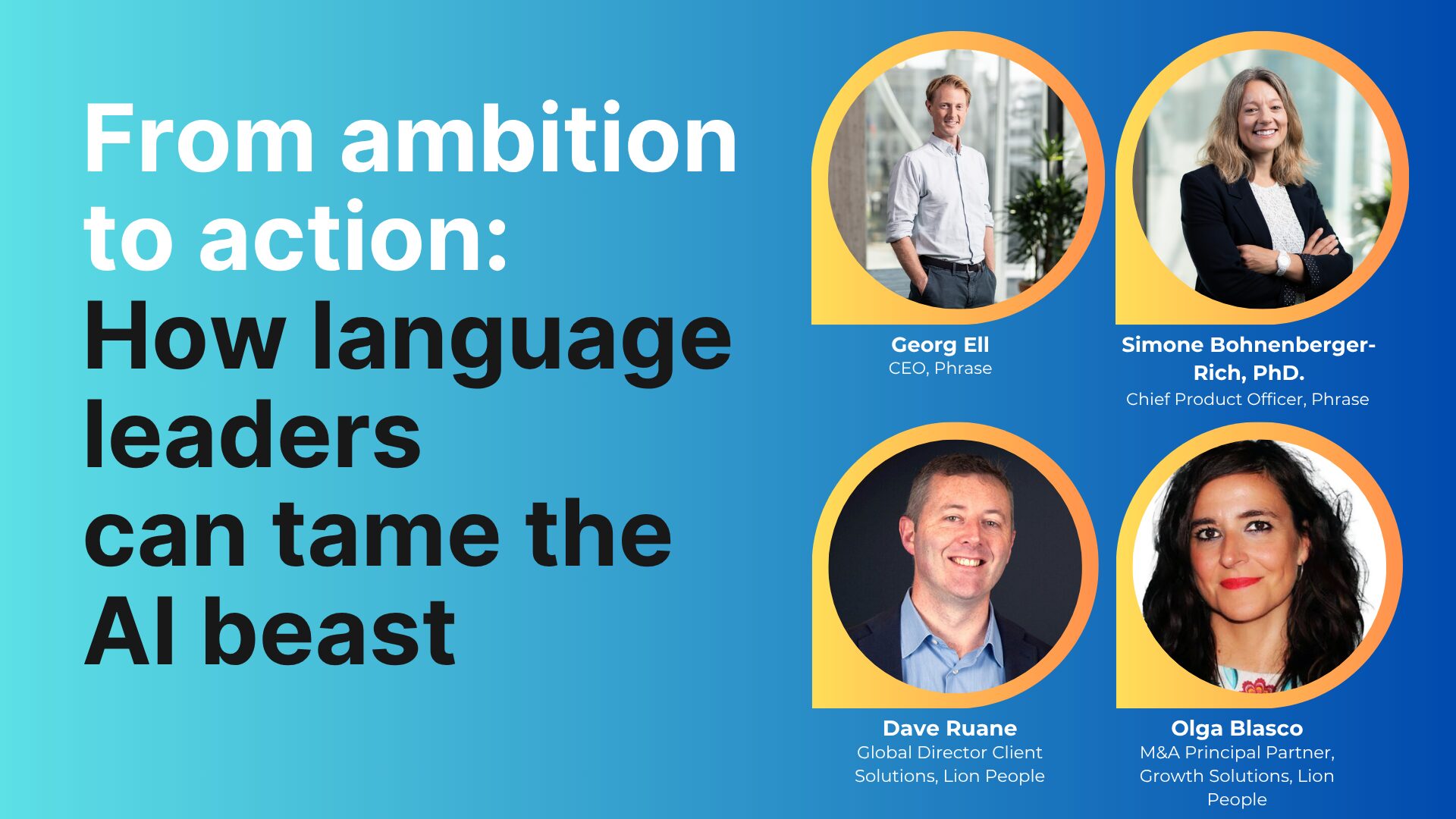Localization strategy
Key Trends Poised to Shape the Language Industry in 2025

2024 has been a remarkable year, with breakthrough tech innovations redefining what localization and globalization teams can achieve.
While AI continues to dominate industry conversations, it is also prompting the industry (no pun intended) to rethink traditional approaches, raising critical questions about the ethics and sustainability of doing business. But AI is certainly not the only talking point.
As we approach the new year, let’s take a moment to look ahead at the major trends poised to shape the language industry in 2025.
AI will remain the catalyst of change
If you were betting on AI being a prominent topic of discussion, you won’t be surprised — it will remain front and center of the debate and a catalyst for the continued evolution of the industry.
So, where will the AI journey take us? Here’s what to watch for:
- AI is reshaping the nature of language work. A big talking point these past two years is that the emergence of AI is leading parts of the industry, most notably linguists, to raise existential questions and wonder about their future, and rightfully so.The debate about AI ethics and work sustainability is, for now, open-ended and will continue well into 2025 and beyond. We’ll revisit this point further in our article.
- Agentic AI workflows. We are only scratching the surface of AI’s ability to transform traditional localization workflows. The next frontier will have autonomous AI agents performing every task in the localization process, from project intake/creation to pre-delivery QA. This will allow humans to move into the driving seat and focus on the destination—where to create impactful user experiences.
- AI is a tool to expand the reach of localization and globalization teams. As Phrase CEO Georg Ell shared at the LocWorld52 conference in Monterey, GenAI has the potential to become a revenue-generating tool. Localization teams can leverage it to open new streams of activity (e.g., customizing content at scale) that expand their importance for the company and directly contribute to its growth.
- AI as a tool to create tailored user experiences. Delivering adapted localized content to the user, respecting the linguistic and cultural richness and diversity of the target audience, and doing so at scale will be something companies operating globally will want to use.
- AI as a tool to enhance product accessibility. AI has tremendous potential to enable access to content for hundreds of millions of users who either don’t have sufficient command of English, prefer to consume content in their native language. It can also support users with disabilities that may prevent them from enjoying the product, such as the communities of Deaf or Hard of Hearing or the visually impaired. Innovative applications of AI in dubbing or captioning make the world more equitable and a place where no one is left behind. Look out for more companies testing novel ways to enable access to their products and expand their audiences.
AI solutions will continue maturing
GenAI has found a firm place in the language technology landscape, with use cases ranging from translation memory cleanup to MT quality estimation, workflow orchestration, AI dubbing, automatic post-editing, and even supporting hyperautomation—the seamless integration of advanced AI capabilities to streamline complex localization workflows.
At Phrase, we’ve integrated GenAI-powered solutions to enhance translation quality, streamline workflows, and scale global content with precision.
These innovations automate language quality assessments, enabling faster, cost-effective reviews while ensuring human-level accuracy. AI-driven tools evaluate translation quality, support machine translation training, and adapt content to match brand-specific tone and style.
By combining adaptive generative AI and brand assets, our solutions deliver culturally relevant, high-quality translations, reducing manual effort and speeding up the entire localisation process.
2025 will be the year of the maturation of existing market solutions, improving accessibility, user experience, integrability, and the quality of results they produce.
It’s not only AI-augmented tech that will continue to mature but also localization and globalization teams’ ability to use it.
Two years ago, there was little to no knowledge about AI, and comparatively low maturity (especially in contrast to localization maturity). Fast-forward to today, most localization programs have had time to experiment with AI and determine how it fits their ecosystem.
Through research, learning, and hands-on experimentation, the understanding of how to make the most of the tech has been improving by leaps and bounds. Everyone is progressing on the AI journey; the only movement is forward.
Dive deeper
Choosing the Right AI Tools for Global Business Expansion
Learn how AI-enabled tools can streamline your localization efforts, helping you expand globally with efficiency and consistency, and explore key criteria for international growth.
Ecosystem evolution: A new era for localization
The real transformation lies in the evolving ecosystem of tools, solutions, and partnerships that enable localization teams to align with broader business goals.
We anticipate groundbreaking advancements driven by AI, integrated ecosystems merging content and localization, scalable personalization, and automated workflows.
These innovations will reshape how businesses approach localization, making it essential to align strategies with business KPIs while preparing for industry consolidation.
Persistent industry challenges will remain
From the buyer’s perspective, one of the main benefits of leveraging language technology—and AI specifically—is the ability to do more with less.
Making AI work is a complex undertaking, but once you implement it (whether in the form of NMT or by leveraging generative AI applications). It allows localization teams to expand their field of activity, further solidifying their place as essential cogs in the company’s global aspirations.
With the AI evolution continuing to play out for the foreseeable future and likely new developments around the corner, some evergreen challenges that localization teams must contend with remain. Let’s review.
- The familiar faces of limited bandwidth and resources are not going away: For every enterprise with dozens of specialists on the team that has it all covered, there will be a handful of companies in start-up or scale-up mode where the localization manager is the only person tasked with managing language-related operations. Additionally there are dozens of companies without a formal localization function. Too often, localization leaders juggle too many responsibilities, and they need to prioritize, possibly leaving opportunities by the wayside. The good news is that technology is a great ally, helping to automate routine and mundane tasks and freeing up hands for the strategic work that boosts the team’s profile and reach.
- Learning and development activities become mission-critical: Our collective ability to make the most of AI resides in our capacity to learn, both to remain relevant and to innovate on the status quo. Continuous learning is becoming a byproduct of rapid AI advancements. Companies are revising their learning and development plans to upskill their workforce and expand the available in-house knowledge.
- Competition is fierce, and companies will want to stand apart from the masses: Every company has a horse in the AI race, developing new features or innovative products. Competition is getting tougher, and it is all about creating opportunities to wow customers, attracting, converting, and retaining them. For the localization teams, the ability to leverage their understanding of local preferences, behaviors, and nuances to create compelling user experiences (UX) will become increasingly vital. This will further blurr the lines between localization and adjacent disciplines such as UX research.
Human vs. machine or human and machine?
As we already highlighted, the debate about whether or not to use AI will likely rage on well into the future, but the future is not about choosing between humans and AI but leveraging both.
Industry professionals will increasingly adopt a human-in-the-loop approach where specialists oversee AI-powered tasks to ensure quality and relevance.
A broader consensus is emerging from different parts of the industry, and the discussion is pivoting away from a man vs. machine mindset to a human AND machine mindset.
Opinions converge around the notion that AI will coexist with humans, not replace them.
The risk of job displacement by AI remains non-negligible, and there is no clear-cut answer as to how specific jobs, such as translators’, will look 10 or 15 years from now (or what they will be called).
However, this may be a moot point for the time being. We are far from seeing an end to the translator role as we know it.
- Varied AI experiments show that humans still have a crucial role in ensuring the AI-generated result matches the end-user’s quality expectations. This is manifested in the concept of human-in-the-loop or human-at-the-core, where human specialists have a central role. This approach is finding more and more proponents on the side of the brands. It is also just plain common sense: While AI is good at performing manual and repetitive tasks, automating and scaling processes, humans have the innate creativity and sensitivity to know what makes other humans tick and how to create impactful experiences.
- Secondly, the language services industry continues to expand in volume and scope—also in part thanks to AI. There is a wealth of work out there for all the professionals in our industry. The implication is that they will need to embrace continuous learning and acquire new skills that will allow them to go and get it.
By the nature of its work, the language industry will continue to be at the forefront of exploring modes of human-AI symbiosis. In 2025, expect to see more companies and individuals sharing their testimonials at conferences or online events.
Dive deeper
Ethical AI: The Evolving Role of Localization Managers
Explore how localization managers play a crucial role in using AI ethically within the translation industry, balancing automation with cultural sensitivity, and addressing issues like bias and transparency to safeguard translation quality and inclusivity.
Regulation will play an increasing role
2025 will see two landmark pieces of legislation, the EU Accessibility Act and the EU AI Act, influence proceedings in the language services industry. These two regulatory developments emerge as something companies must pay special attention to. Let’s touch on the immediate consequences of both.
- Companies doing business in the European Union have until June 2025 to comply with the EU Accessibility Act. In its broadest sense, the act is intended to ensure people with disabilities have equal access to products and services, especially those in the digital realm, such as websites or apps. Beyond the legal implications, what is remarkable is that the act is intended to break down barriers—and language can be just such a barrier to access. In just a moment, we’ll explore accessibility as another driver of the evolution of the language service industry.
- The EU AI Act, the first-ever legislation about AI, has the merit of establishing rules for AI governance and creating trustworthy AI, which is of paramount importance from the perspective of the end-user engaging with AI-augmented products and content. As a user, transparency and trustworthiness are key considerations when engaging with any brand (especially when a considerable portion of the AI debate is around its more negative aspects, such as hallucinations). Specialists point to applications of AI in the language industry being at a minimal to limited risk of the risk-based evaluation of AI systems proposed by the EU. Yet, companies using GenAI for content generation and translation will have to abide by transparency rules established by the act.
Europe is leading the way in regulation, and two of its more significant acts already have implications for companies using translation and localization to reach millions of users. As we forge ahead with more AI in our lives, regulatory developments will continue in parallel, protecting the end-user.
Embracing accessibility and inclusivity
Lastly, let’s touch on a couple of trends that are here to stay and ones we expect to hear more about in 2025 (and not just because of the EU Accessibility Act we already mentioned): accessibility and inclusivity.
Let’s be clear: Language is a means of access. Companies foregoing language (i.e., localizing their offering) inadvertently decide to exclude people from enjoying their products, strategy that’s rarely in their best interest.
Enter the professionals and companies in the language services industry uniquely positioned as experts in language and language focused AI-solutions.
Their support is invaluable for companies aiming to reach new audiences, especially given Gen Z’s expanding influence in public discourse and economic life. Questions of social justice, access, and inclusion matter and not necessarily only to the younger generations.
Now enterprises are developing programs around these topics and seeing the first positive results of their labor.
2025 should be the year of accessibility and inclusivity moving from being a curious side conversation to something systemically implemented and required at all stages of product development and localization.
A future defined by innovation and collaboration
The language services industry in 2025 will be shaped by continuous technological advancements, evolving human roles, and an integrated ecosystem of tools and partnerships.
Businesses must adopt AI-powered tools while fostering creativity, cultural insight, and empathy to stay competitive and relevant.
Success will depend on balancing cutting-edge technology with human-centric strategies, ensuring continuous learning, innovation, and personalized user experiences.
Those that embrace this dual approach will be well-positioned to drive growth, enhance customer satisfaction, and create lasting market impact.
At Phrase, we are committed to advancing tech-powered localization through innovation, collaboration, and ecosystem-driven partnerships.
By enhancing user experiences and enabling business success, we are ready to lead the language services industry into its next era of opportunity and transformation.
Discover more
Harness Gen AI to Scale Your Localization
Discover how Phrase can help you revolutionize your translations with generative AI tech.








